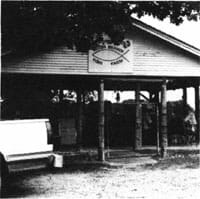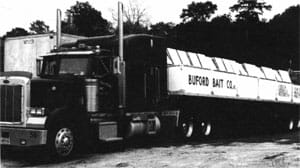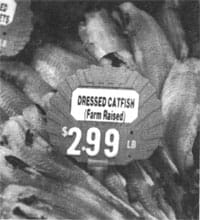Marketing is as important as production, financing, cash flow and other profit determining factors in aquaculture enterprises. Similar principles are applicable to small- or large-scale operations. Before beginning production, or selecting a specific marketing alternative, some general marketing principles should be considered, and a marketing strategy developed. Most fish producers are production oriented rather than market oriented. The producer who develops a sound marketing strategy, and considers marketing as important as production, will have a definite economic advantage over those who don’t.
Developing a marketing strategy involves three elements: 1) determining present situation; 2) determining final marketing goals; and 3) developing a logical plan for getting from the present situation to the final goal.
Determining the present situation often involves the most work and time. Make assessments of the market, personal financial circumstances and available marketing alternatives. An understanding and assessment of a particular market is required, including the importance of supply and demand and maintaining a timely awareness of the current market situation and trends. Use enterprise budgets to help in assessing various marketing alternatives. The most profitable marketing alternative may be unacceptable because of time required, unacceptable cash flow, or incompatibility with other personal or business goals.
The second element, determining marketing goals, is based on assessments made during the determination of the present situation. If attainable marketing goals are not established, the producer may drift aimlessly through sales opportunities. Relate goals to operating costs. Know how much different levels of operation will cost and establish goals that will at least cover costs. The level that goals exceed operating costs will depend on the willingness to accept risks and other personal and business goals.
Finally, consider all reasonable alternatives, and develop a marketing plan. Evaluate the operation, labor and financial requirements, and other advantages and disadvantages of each alternative. The selection of a specific or combination of marketing alternatives should be tailored to the market assessments, individual financial circumstances and the size of the operation.
After a marketing strategy has been developed, write it down. Test the strategy through several hypothetical cases and modify as necessary. Think through all the things that could happen. Once a final strategy has been selected, follow it. Lack of marketing discipline is a common management problem.
The purpose of developing a marketing strategy is to provide direction for actions. The objective is to maximize the probability of achieving marketing goals. Marketing management is an obligation that can’t be ignored.
Marketing Alternatives
 |
Aquaculture products marketed on a small-scale include sport fish such as channel catfish and rainbow trout, baitfish (e.g., golden shiners and fathead minnows), and aquatic invertebrates such as crayfish. The previously discussed marketing considerations apply regardless of the species involved. The most common species produced and marketed on a small scale in the southern United States is the channel catfish. The following discussion of marketing alternatives deals primarily with channel catfish.
Fee Fishing or Pay Lakes
Fee fishing is an attractive marketing alternative for many small-scale producers. The increased demand for fishing opportunities and per capita consumption of fisheries products have led to rapid expansion and development in this market. A major benefit is the premium price paid for fish. The price per pound may be as much as double that paid by large processing plants.
The initial step in establishing a fee fishing operation is determining what the customer wants. Fishermen’s preferences vary from one geographic area to another. This determination should include not only the species and size of fish to use, but also conveniences such as concessions, bait, tackle, restrooms, shaded areas, benches, etc.
Additionally, the potential fee fishing operator must determine where, how and when to sell. Location is an important consideration in determining if fee fishing is a viable marketing alternative. Ideally, fee fishing ponds should be easily accessible from a heavily traveled road near an urban center. Fee fishing customers appreciate convenient parking areas and easy access to ponds. The site should be identified with large signs on the nearest major road, and additional signs on secondary roads. Most fee fishing operations depend on word-of-mouth advertising to attract customers. It is essential that potential customers be able to locate the fee fishing operation.
 |
| Holding tank and business area for fee fishing operator. |
Fee fishing ponds are usually operated seasonally. Most operations are open daily from early morning until dark during spring, summer, and fall. Many operators reduce hours or days of operation during colder months. Hours should be specific and clearly stated on signs and in advertisements, and posted in a conspicuous location at the facility.
Family Operations
Pay lake operations tend to be family operated and provide supplemental rather than primary income. Many pay lakes are part of diversified farm operations. Few pay lake operators have formal training in aquaculture or business. Consequently, many pay lakes are managed inefficiently. Few operators keep accurate records of costs or income. Keeping accurate records of stocking densities, time of stocking, catch rates and customer needs would give the novice operator a definite marketing advantage over most established operations.
Marketing through fee fishing requires a willingness to deal with the public and to work long hours, often seven days a week. Considerable management ability is required to provide maximum returns. The primary advantage is the premium price received by the operator.
Channel Catfish Popular
Many species of fish are marketed through fee fishing; however, the channel catfish is by far the most popular. Channel catfish are usually available throughout the year, can be purchased at desirable sizes, are easily caught, and do not reproduce in open ponds that do not have holes or cavities. The size of fish commonly stocked varies from about 1 to 6 pounds. Some pay lake operators like to have a variety of sizes in the pond, while others prefer consistently small or large fish. Discussions with existing pay lake operators in the area will provide insight into local customer preferences.
It is not reasonable to produce and sell channel catfish from the same pond. Usually, fish are purchased from outside sources or raised in other ponds. Attempting to raise channel catfish in ponds open to fishing results in the ponds being open for only a few months of the year; a large number of small fish that are unacceptable to the customer; and fishermen returning a large number of stressed fish that die or learn hook avoidance.
Stocking densities vary from a few hundred to over 8,000 pounds per acre. Higher stocking densities do not necessarily mean higher catch rates, but are related to potential water quality problems, such as decreased dissolved oxygen. If the weight of channel catfish in a pond exceeds 1,500 pounds per surface acre, aeration equipment should be available. If stocking densities exceed about 3,000 pounds per surface acre, aeration is a necessity.
Catch rates in fee fishing ponds appear to be related to time exposed to angling. In recently opened ponds stocked with fish that have not been exposed to angling, catch rates are very high, often over five fish per angler hour. Typically, within a few days catch rates decline to less than one fish per angler hour. This suggests it may be more desirable in fee fishing ponds to frequently replace fish rather than attempt to carry high densities.
Four replacement programs are commonly used:
- replacement of fish caught
- replacement based on number of customers or receipts
- regular scheduled replacement
- seasonal (weather or holiday related) replacement.
Individual operators will have to determine the best replacement program for a particular facility. More frequent replacement requires considerable time for scheduling and more meticulous record keeping. The most efficient and profitable fee fishing operations are those that move the maximum pounds of fish in the minimum time with the least obligation of limited resources. Frequent replacement in a relatively small pond containing a moderate density of fish has the potential of the most return on investment.
Channel catfish in fee fishing ponds usually are fed only a maintenance diet. Few operators attempt to promote fish growth in the pond. Fish are fed 1 to 2 percent of the estimated weight of fish in the pond, two or three times per week. A commercial catfish ration is usually fed.
Marketing Other Species
Other fish such as rainbow trout or hybrid striped bass are marketed through fee fishing facilities. Rainbow trout require an abundant supply of high quality cool water. Trout fee fishing operations generally are limited to locations at which summer water temperatures do not exceed 70° F. General operating procedures at trout fee fishing facilities are similar to those described for catfish. Because of increasing demands for high quality water and restrictive water use regulations, it is difficult to locate or purchase undeveloped sites appropriate for trout fee fishing operations.
In many areas of the southern United States pond water temperatures are less than 70° F for four to six months of the year. Fee fishing facilities in these areas could sell rainbow trout seasonally. Trout are active and feed well when catfish are sluggish and not biting. Using a combination of catfish and trout could extend the fishing season and improve the cash flow of some fee fishing operations.
Hybrid striped bass recently have become available from commercial producers. Hybrid striped bass are easily caught by hook and line and could be marketed through fee fishing. As hybrid striped bass become more available they undoubtedly will enter the fee fishing market. Striped bass and hybrid striped bass are important game fish throughout the southern United States. In many states there are specific game and fish regulations concerning their production and marketing.
Live Haulers
 |
| Live hauling truck. |
Small-scale producers may sell fishes to live haulers. Live haulers usually buy fishes at the pond bank, then transport and sell them at other outlets such as processing plants, pay lakes, recreational lakes, or retail outlets. Small-scale producers often have difficulty working with live haulers because the producers lack proper equipment and experience. Live haulers need to know exactly how many pounds, what size, and when fishes will be available. Live haulers prefer not to handle small quantities of fish, less than 1,000 to 2,000 pounds, and in some areas not less than 5,000 to 10,000 pounds. Some live haulers may use small trucks to transport fishes within restricted geographic areas, providing an outlet for 500 to 1,000 pounds of fish at a time. They prefer that fish be of a consistent size.
Grading at the pond side is desirable. The producer should have a weighing system so that no doubt exists about how many fish are being sold. Since many small-scale producers do not have extensive holding facilities, fishes are often loaded directly from the pond to the hauling truck. This results in poor quality water in the hauling tank. A supply of fresh, high quality water is desirable to flush out the hauling tank. Live haulers usually do not provide harvesting services. Therefore, the producer has to have the equipment and ability to harvest and load fishes quickly.
Catfish, trout and baitfish are bought by live haulers. Live haulers are an especially attractive market for small-scale baitfish producers because of the difficulty in entering the well established and controlled baitfish distribution system.
Direct Sales to the Public
 |
| Retailers require a constant supply and consistent size product. |
Another marketing alternative is direct sales of live, whole or processed fish. This option requires a holding facility but offers the advantage of a premium price with a minimum amount of dealing with the public. Specific hours of operation can be established. Small producers may be open only a few hours one day per week. This allows efficient scheduling of time and reduces time lost waiting for a customer. Orders for fish can be taken prior to pick up with all customers required to pick up fish during a specified time.
If processed fish are sold directly to the public, sanitary processing facilities are required. Local public health officials should be contacted concerning regulations for processing and selling aquaculture products.
Direct Sales to Restaurants, Grocery Stores, and Other Retail Outlets
Direct sales to restaurants, grocery stores, or other retail outlets often appear to be a viable marketing alternative for small producers. In most cases they are not. Although there may be many retail outlets in the vicinity, they require a constant supply and consistent size product. A small producer probably will have fish available for only a very short time. Even though the producer might be able to deliver a quality product at a reasonable price, the retail outlet manager will usually choose an established distributor or large producer for convenience and dependability.
Permits and Licenses
Fee fishing operations are regulated by state agencies such as the Department of Natural Resources, Department of Conservation and in some cases the Department of Agriculture. Additionally, local business permits may be required. If fish are processed, the public Health Department may require certain permits be obtained or specific procedures be followed. Prior to selecting a specific marketing option, contact local regulatory agencies such as the Department of Natural Resources or service agencies such as the Cooperative Extension Service concerning local regulations and permit requirements.
Advertising
Advertising pays. Regardless of the marketing alternative chosen, a sound advertising program will increase sales and profits. Small-scale producers seldom consider advertising important or include advertising expenses in budgets. Most small-scale producers assume incorrectly that a few signs and word-of-mouth will provide a profitable enterprise. Traditional advertising outlets such as newspapers, radio and local cable television should be used. In addition, sponsoring special events and working with local outdoor writers can significantly increase profits.

